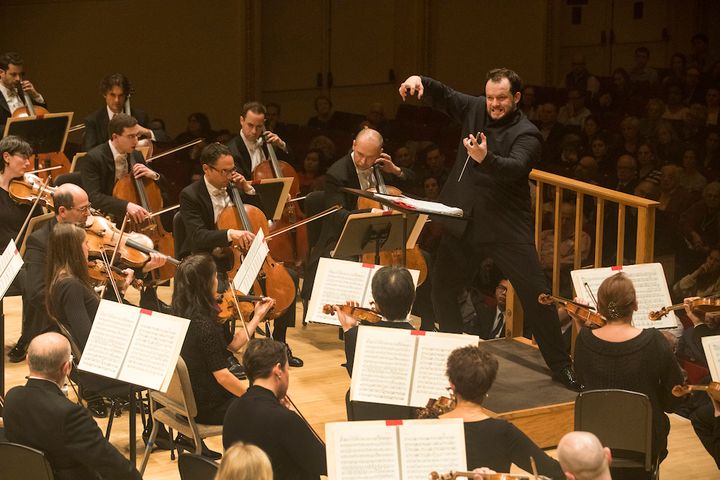
Andris Nelsons conducting the Boston Symphony Orchestra at Carnegie Hall.
By Joshua Rosenblum, ZEALnyc Contributing Writer, March 9, 2017
Sofia Gubaidulina (b. 1931) is one of our great living composers, but when she was a student in Soviet Russia her work was deemed “irresponsible” for its modernist tendencies, like the use of alternative tunings. Fortunately for her, she had the support of Dmitri Shostakovich, who urged her to continue on her own path—a risky thing in those days for Russian composers, as Shostakovich himself well knew. That turned out to be great advice, however, and Gubaidulina’s compelling brand of musical originality was on full display with the New York premiere of her Triple Concerto for Violin, Cello, and Bayan on February 28 at Carnegie Hall. Performed by the magnificent Boston Symphony Orchestra under Music Director Andris Nelsons (which had given the piece its world premiere in Boston five days earlier), Gubaidulina’s piece radiated intensity, soulfulness, and often bleakness, as well as her distinctive brand of tragic beauty.
The bayan, a Russian chromatic button accordion (i.e. no keyboard), is a favorite instrument of the composer’s. In fact, the piece begins with the bayan alone, playing a fraught, dissonant chord in the instrument’s low register. Elsbeth Moser, the expert bayan player (and the piece’s dedicatee) demonstrated how expressive the instrument can be while merely sustaining a single chord. Gubaidulina, who has written about a dozen works for the bayan, has reconceived it as a virtuoso instrument of contemporary music. She also combines it expertly with instruments of the orchestra, particularly the low strings, tuba, and bass trombone, in growling, ominous sonorities. The composer builds the piece from a motif of parallel tenths sliding up and down chromatically, three notes at a time—this expressive fragment is introduced by the bayan and gradually radiates outward to the full orchestra. In some iterations, it sounds like a mournful yowl from deep within the tortured soul of Mother Russia herself. Listening to the piece unfold, one could both follow the development analytically and feel the intensity viscerally. The solo violin (Baiba Skride) and solo cello (Harriet Krijgh) have intense interplay as the composer keeps coming up with electrifying ways to build intensity. Gubaidulina makes her own rules for sonority and musical development, and the listener forgets for a while that there’s any way to do it other than hers. All three soloists showed fierce commitment to the piece’s searing profundities (as well as thorough mastery of its considerable challenges), and reveled in its searing beauty. The response to the composer as she stood at the foot of the stage after the piece was worshipful, from soloists, orchestra, and audience alike.
For the second half, the orchestra presented Shostakovich’s monumental Seventh Symphony, a gargantuan work that had its premiere in 1942, during the German army’s siege on Leningrad. The so-called “invasion theme” in the first movement is one of the most famous passages in the twentieth century symphonic repertoire. (Bartok even parodied it in his Concerto for Orchestra.) Like everything relating to Shostakovich and his wartime compositions, however, it is loaded with controversy. The Symphony was presented as a symbol of resistance to Nazi aggression, but Shostakovich had begun working on the piece well before the siege, and hinted to friends that the piece was about resisting tyranny in general and Stalin in particular.
Regardless, the passage is riveting and astonishing, as it grows from a quiet theme in the pizzicato strings, driven by snare drum accompaniment through a wild set of orchestrational and harmonic variations. (Think Ravel’s “Bolero,” except more savage.) Nelsons started the passage with quiet, suppressed energy so you could feel where the piece was going over the course of the long crescendo to follow. The climax was thrilling, and Richard Svoboda gave a singing, haunting account of the extended, eloquent bassoon solo that follows.
The rest of the piece (with three movements and about fifty minutes still to go) can be heard as a requiem for a lost way of life; whether it’s at the hands of Stalin or Hitler is immaterial on musical terms. The third movement spills over with nostalgia, like a meandering journey through an extended succession of vivid memories, ending where it started. Under Andris’s compelling leadership, the contrasts were striking, and the fast sections were electrifying, but it all took place, as intended by the composer, in a context of loss and regret. The apocalyptic C major climax at the end of the galvanizing last movement is laced with bitterness and irony. Andris and the BSO made the whole hall shake in the drive to the finish, but it also felt like the spectacular conclusion had come at a great cost, physically and emotionally. Shostakovich would have approved.
_________________
Boston Symphony Orchestra in concert at Carnegie Hall on February 28, 2017. Andris Nelsons, Music Director and Conductor. Soloists: Baiba Skride, violin; Harriet Krijgh, cello; Elsbeth Moser, bayan.
SOFIA GUBAIDULINA: Triple Concerto for Violin, Cello, and Bayan (NY Premiere, co-commissioned by Carnegie Hall)
SHOSTAKOVICH: Symphony No. 7, “Leningrad”
_________________
Joshua Rosenblum is a Contributing Writer for ZEALnyc and writes on classical music performance, theater, and related topics.
For more ZEALnyc features, read:
For all the news on New York City arts and culture, visit ZEALnyc Front Page.
